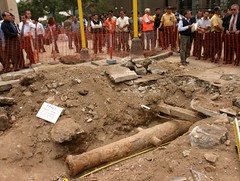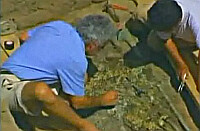Colonial cannon discovered beneath Lima’s streets

ANDINA/Hector Vinces
A cannon dating from Peru’s Spanish colonial period has been found by workers constructing part of Lima’s new Metropolitan transport system and underground central station. Unearthed at the intersection between Camaná and Emancipation, the cannon measures 2.79 metres long and is in good condition.
An archaeologist from the country’s National Institute of Culture (INC), Carmen Gabe Benaki, explains that the cannon was likely to have been reused in the 1800s to protect an old mansion that once occupied the site but no longer stands. During the building’s demolition it would have been left in place and become buried.
It seems this was not the first time this particular item had been rediscovered. The cannon was found just centimetres below tubes in which the cables carrying power to the street lights run. Laid 30 years ago, it is likely that the workers placing these tubes ignored the historic cannon to avoid delays by archaeologists and the responsibility for retrieving it.

ANDINA/Hector Vinces
The INC has now given permission to the company carrying out the construction, Protransporte, to move the object to the museum in the Parque de la Muralla for further study, and so that work can continue on the site.
Tags: Archaeology, cannon, colonial, INC, lima, parque de la reserva, spaniards



![Loosing weight in Peru [Featured]](http://farm4.static.flickr.com/3263/2894149292_88b26222f4_m.jpg)



![A Tango With My New Charango [Featured]](http://farm1.static.flickr.com/13/14395819_078370ba2e_m.jpg)


